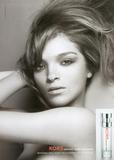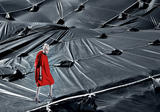MissMagAddict
Well-Known Member
- Joined
- Feb 2, 2005
- Messages
- 26,630
- Reaction score
- 1,310
Source | Hint Fashion Magazine | Special Thanks to The Imagist

HINTERVIEW:
Fabien Baron: One-Man Brand

Fabien Baron—graphics guru, branding visionary, creative director extraordinaire, multitasking myth-maker—can do more in 15 minutes than just about anyone. So it was no great surprise when news spread earlier this year that he'd been named editorial director of Andy Warhol's Interview (as well as Art in America and Antiques), a title he shares with style writer Glenn O'Brien, both of whom had worked for the magazine before. The September issue marks the official relaunch, but Baron has already been putting Warhol's axiom to the test with three "warm-up" issues, as he calls them, one of which featured Marc Jacobs on the cover in a gray-white tousled Warholian wig. But while Baron can whip up miracles in mere minutes, give him 15 years and he can recreate the publishing universe. That's exactly what happened when he was appointed creative director of Harper's Bazaar in 1992. His signature negative space splashed with oversized letters became the aesthetic benchmark to imitate and himself a Warhol-worthy superstar. All the while, with his branding agency Baron & Baron and its staff of dozens, he's been conceiving and realizing the ad campaigns and product designs for such blue-chippers as Calvin Klein, Burberry, Balenciaga, Dolce & Gabbana, Prada and Giorgio Armani, to name only a few. Here, at his new Hudson St. digs in Tribeca, where straight lines and right angles still dominate (save for massive round light fixtures), the unflappable maverick opened up to Lee Carter about everything from his Interview redesign to his designs on the White House.
This is my first time in your new office. Last time we met was on 57th St…
I'm so glad not to be there anymore.
Why did you move?
It was too small and too…well, too small.
You're still going through growing pains. How do you juggle everything?
I'm a perfectionist. I'm very respectful of deadlines, but I usually hold back if I know there's a little something wrong. It doesn't go out if it's not right.
Everyone says they're a perfectionist. Do you have a note from a doctor?
I should. It's almost a disease. I don't know what it is, if it's control or because I just like to do things well. I'm like an athlete trying to break a record. (Phone rings.) It's Craig McDean calling about a layout. He wants me to send it to him, but I'm not finished—exactly what we were talking about.
In our last interview, you were saying you're always on the go…
That hasn't changed.
Where have you been of late?
I'm still doing a lot of magazine work, packaging, ad campaigns, photography and commercials. I mix my mediums. I like that. I find it easier to work.
Which commercials?
For Calvin and Giorgio Armani.

And, of course, there's Interview. Has that started?
Yeah, kind of. September is the official first issue, but we're putting out three issues before that, like warm-ups.
What's different with September?
The size is new, the paper is new. I think the photography and attention to all the details will be new. It will be a total redesign.
Who's on the September cover?
I can't tell you! (Laughs.)
What exactly is your role is there?
I'm editorial director, one of them, with Glenn O'Brien. I share the title with him. He's an old partner of mine.
You've been friends for a long time.
I've worked with him for about twenty years, and with Karl [Templer, creative director] for fifteen. I've known Peter [Brant, publisher] for about twenty.
Like a family…
We're all connected. And with that we create a buzz, I guess, which goes back to what Andy tried to do. The Factory was an open house. None of us overshadows the others. Karl is very fashion, I'm very visual, Glenn is very wordy. And each one of us is interested in what each other finds. Together, we're taking care of three magazines [Interview, Art in America, Antiques], redesigning them and repositioning their editorial content.
To be sexier? More intellectual?
To be more of a reflection of what's going on today. I think Interview was basically a style magazine invented by Andy Warhol for his friends to be in it, a vehicle for showing stylish people, to bring marginals and high society together under the same roof. He was really obsessed with fame. We have plans to make it much more important than it's ever been.
Will anything stay the same?
I like the name.
What's the competition?
I don't think there is any. The thing with Interview is it's at the crossroads of art, fashion and entertainment, which we can treat in a very authoritative way. It's a unique position that not many magazines can accomplish. Today one jumps between the worlds of art, fashion and entertainment all the time. Designers hire artists to work on their products, while artists want fashion people to be interested in their work, and they both care about fame the way Hollywood cares about fame. Where before these fields were very elitist, today they spread out everywhere. They're interacting more than ever, overlapping and becoming almost one. Interview will represent that. We can make a special fashion issue and be believable, or make a special art issue and be believable, or do entertainment.
It seems like that's what Andy would've wanted.
And it's what he did very well. He was able to mix glamorous and trendy on the same page, to show the worlds together as one. We can be the ambassadors of this vision.
A big swirl.
Yes. Vanity Fair rules Hollywood, American Vogue rules fashion, and Art Forum rules the art world. I think we can have the authority where those three fields meet, to own that spot. If Vanity Fair were to do an art issue, they would focus on where the money is coming and going. They would seek out the underbelly of the art world, to fit the position of the magazine. And if Vogue did it, where will they put the fashion? They could only do a six or eight page story. I'm not saying it would be bad. It would be very valid, very much like the piece you need to see about the art of the moment—what's coming up at the Met or the Modern. But they'll never be able to get into the story like we can. We can blow twelve pages on an artist, show his art and interview him, then another artist right after that. Then a portrait of sixteen artists, or some big collector, etc. At the same time we can have special backstage story on Paris couture. Then we can interview Martin Scorsese or do a big thing on Brad Pitt. It's vast. And the three categories of art, fashion and entertainment need and want each other more than ever, the same way they did in the 60s and 70s. It's all more and more connected.










































 Now I'm very intersted in this man. They are helpful for me.
Now I'm very intersted in this man. They are helpful for me. 